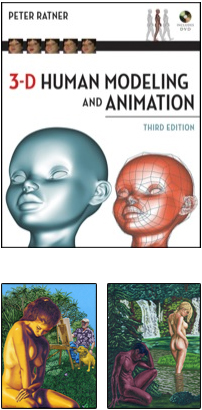3D Human Modeling and Animation Book + Free Chapter

”PROPORTION
Throughout history, artists have tried to depict the human figure in ideal proportions. Generally, the average height of a man or a woman can be measured as seven heads tall. When seen on a two- dimensional surface, the seven- heads- tall figure does not satisfy the concept of the ideal. Compare the same female in Figures 3-1 and 3-2. The model in Figure 3- 2 that is eight heads tall appears more elegant and statuesque. If your goal is to create and animate the ideal male and female, then consider modeling them eight heads tall. If you are using 2- D or 3- D templates, stretch their proportions first and then use them as your guides. Then again, if you are planning to create caricatures, try making the heads extra large and the entire body only five or six heads tall. Superheroes are often portrayed as very tall with tiny heads.
Sometimes an artist will deliberately create a model according to the manner in which it will be viewed. Michelangelo’s David is a perfect example of this. Since the size of the statue was modeled to be very big and was meant to be viewed by looking up at it, Michelangelo had the foresight to model the head extra large, knowing that viewed in perspective it would look normal. Figure 3- 3 illustrates the average shoulder width of the female and the height of the torso. The female appears to have a shoulder width of two and two thirds heads. The male has a shoulder width of three heads (Figure 3- 4). Measured from the top of the head to the crotch, both male and female are approximately four heads tall. Although at first it helps to know the general proportions according to certain measurements, it is better to rely on your own eyes and judgment regarding what looks right and what does not. With experience, one learns to gauge proportion according to one’s own good sense rather than spending time measuring the figure with a ruler.”
Here is the link to Peter Ratner’s portfolio: http://peter-ratner.
